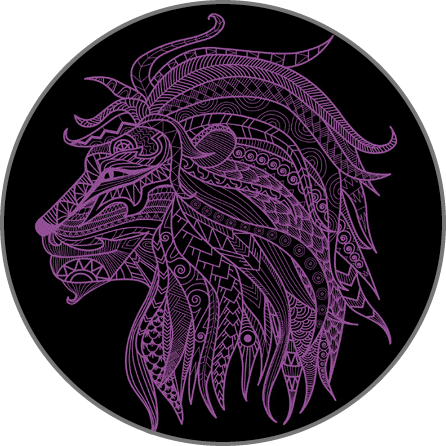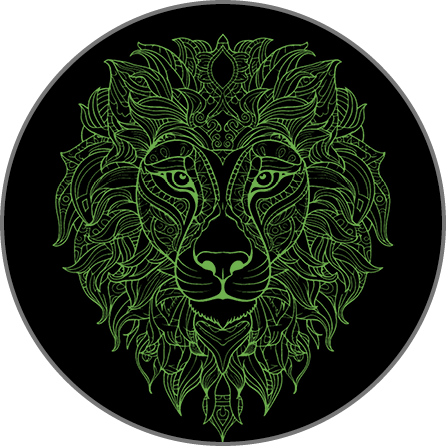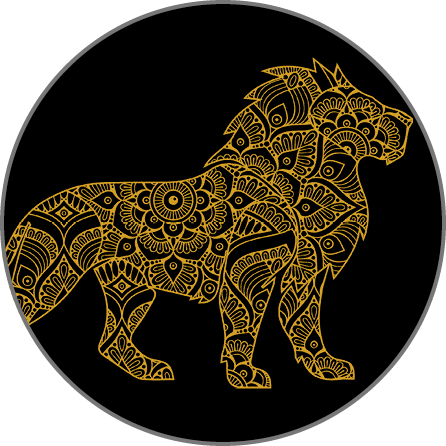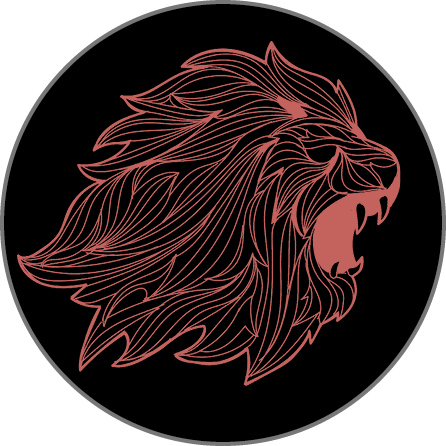Lion Mandala Animal Art [2]
![]() A Granite Bay Design Microsite: Animal Mandala
A Granite Bay Design Microsite: Animal Mandala
The Lion

![]()

The Lion in Islam
In both Arab and Persian culture, the lion is regarded as a symbol of courage, bravery, royalty and chivalry. The depiction of lions is derived from earlier Mesopotamian arts. Islamic art commonly manifests its aesthetic elements predominantly in Islamic calligraphy, floral and geometric decorative patterns, since Islamic religious tradition discourages the depictions of humans and living creatures in sculptures. Through Persian arts miniatures and paintings, however, the depictions of humans and animals survives.[citation needed] In al-Andalus (Muslim Spain), lion statues as supporters and waterspouts of fountains were built around 10th-century Cordoba, such as in the palaces of Madinat al-Zahra and Munyat an-Na’ura, as well as in the Maristan of Granada and in the Court of the Lions of the Alhambra in the 14th century.[47][48] Animal motifs were also commonly used in stone-carved decoration in Anatolian Seljuk architecture (12th–13th centuries) and images of lions were favoured in this context. Examples include the lion reliefs on the Döner Kümbet tomb (c. 1275) and the lion-head carvings on the Sahabiye Madrasa (c. 1267), both in Kayseri, and two reliefs of a lion fighting a bull on the Great Mosque of Diyarbakir.

The Lion in Ancient Egypt
The earliest tomb paintings in Ancient Egypt, at Nekhen, c. 3500 BC, classified as Naqada, possibly Gerzeh, culture include images of lions, including an image of a human (or deity) flanked by two lions in an upright posture. Among ancient Egyptians, from prehistoric times through well documented records, the war goddess Sekhmet, a lioness,[5] later depicted as woman with a lioness head, was one of their major deities. She was a sun deity as well as a fierce warrior and protector. Usually she was assigned significant roles in the natural environment. The Egyptians held that this sacred lioness was responsible for the annual flooding of the Nile, the most significant contributing factor to the success of the culture. Sometimes with regional differences in names, a lioness deity was the patron and protector of the people, the king, and the land. As the country united, a blending of those deities was assigned to Sekhmet.

The Lion in Chinese Culture
In Chinese culture, the bull is linked to farming, and the story goes that The Emperor of Heaven felt sorry for the starving people. So he sent the oxen on Earth to tell the people that they would not starve if they worked hard. Other myths speak of the Yan Emperor, who was a mythological figure depicted with the head of an ox. It is believed that he was the first who built up fields. Tibetan people believe the bull relates to strength, success, and wealth, and is viewed as the token of determination and perseverance.

The Lion and Early Man
The earliest known cave paintings of lions (which are of the extinct species Panthera spelaea) were found in the Chauvet Cave and in Lascaux in France’s Ardèche region and represent some of the earliest paleolithic cave art, dating to between 32,000 and 15,000 years ago. The zoomorphic Löwenmensch figurine from Hohlenstein-Stadel and the ivory carving of a lion’s head from Vogelherd Cave in the Swabian Jura in southwestern Germany were carbon-dated 39,000 years old, dating from the Aurignacian culture.

About the Animal Mandalas
Animal mandalas range from simple designs featuring cute little puppies and kittens that appeal to children, to detailed works of art ripe with spiritual symbolism. As an artistic tool for children, animal mandalas can supplement learning and provide an outlet for creative expression. For adults, the symbolism and meaning of the design may be more important. Consider the use of the mandala before you choose an animal design.

